From ancient legends of native traditions to Thomas Jefferson's archaeological expeditions to the mysterious question of the alleged 'cover up' by the Smithsonians Institute
di GianMario Mollar
article originally published on FarWest.it.
Forget, just for a moment, the evolutionary theories you studied at school and let's start over. Once upon a time ... there were giants. A Paiute legend tells the story of the Si-Te-Cah, an ancient bloodline of giants with red hair cannibals that sowed terror in what is now called Nevada. The name literally means "rush eaters," and refers to their ability to weave the fibers of this aquatic plant to build rafts, used to wage war with their Paiute enemies. The giants, in fact, were in constant conflict with the native tribes who, after long conflicts, coalesced to exterminate them. The last survivors managed to entrench themselves in the Lovelock Cave, Nevada, but the Indians piled up some brush in front of the opening and set them on fire. Those who did not asphyxiate by smoke were killed with a shower of arrows and thus these ancient and mysterious inhabitants of American soil became extinct.
Sarah Winnemucca (1844-1891), native writer and daughter of a tribal chief, in her book Life among the Paiutes: their wrongs and claims [1], corroborates this legend, although it does not openly refer to the stature of these ancient adversaries of his people. His testimony speaks of a "small tribe of barbarians" that ate human flesh:
“After my people exterminated them all, the tribes around us called us Say-do-carah, which means 'conqueror', but also 'enemy'. My people say that the tribe we exterminated had reddish hair. I own some of that hair, an heirloom that has been passed down from father to son. I have a dress that has been in our family for a great number of years, woven with that red hair. I intend to wear it at one of my upcoming conferences. It is considered a mourning dress, and no one has such a dress besides my family. "
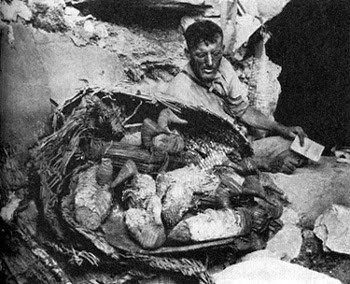
Expeditions to Lovelock Cave
Many years later, in 1911, two miners, James Hart and David Pugh, set out to mine in the area. They are not "bone hunters," as archaeologists were called at the time, but far more prosaic guano diggers at the Hawaiian Fertilizer Company of San Francisco. Bat droppings, in fact, have always been used as fertilizer and at the time they were also used to produce gunpowder and explosives, due to the high concentration of nitrates. Working with shovel and pickaxe, the two come across some prehistoric finds, which point to Professor Alfred Kroeber, founder of the Department of Anthropology at the University of California. This fortuitous finding gives rise to the first archaeological expedition to Lovelock, in 1912, and to a later one in 1924.
Excavations are coordinated by LL Loud and are proving incredibly fruitful, as as many as ten thousand finds are brought to light: baskets, vases, tools, weapons, bones, duck baits - of truly admirable workmanship, among the oldest known in the world and still with some feathers attached - and about sixty mummies. Radiocarbon dating tells us of an almost 5.000-year-old civilization: the cave was quite busy in 2.850 BC, a little less around 1.000 BC, until 440 BC, when a collapse blocked access to much of the cave.. From then on, the bats became the only inhabitants of the cave, burying the artifacts and bones of the ancient inhabitants under a layer of excrement varying in thickness from one to two meters. Two of the bodies found are really strange: they have reddish hair and are taller than average. There is a female mummy that is almost two meters high, while the male one exceeds two meters and forty!
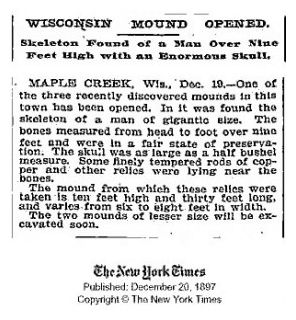
But that's not all, because the Lovelock cave holds other surprises: a 38 cm long sandal - a size 54! -, the imprint of a hand, almost twice the size of a "normal" hand and some human bones, fractured in order to facilitate the sucking of the marrow. In short: the ancient legend of cannibal giants seems to come back to life and knock on the doors of history. And Lovelock's findings prove it ... at least in theory.
The artifacts mentioned can be seen at various museums, duck bait at the Smithsonian in Washington DC, baskets and bones at the Nevada State Museum, and many artifacts at the small natural history museum in Winnemucca, Nevada. Of the remains of the giants, however, no trace remains. According to some, they were damaged and lost during excavations, which did not have the accuracy and rigor of our days: it is even said that one of the most beautiful specimens was put to boil and destroyed by a local Masonic lodge. who intended to use the skeleton for unspecified initiatory purposes.
According to others, however, such remains never existed. Among these, the anthropologist Adrienne Meyer, who claims that the giants are a hoax invented in order to attract tourists to Nevada, and that the skeletons found were all of normal size [2]. Meyer also explains the tawny color of mummies' hair: after hundreds of years of burial in a soil with particular climatic and chemical conditions, the pigment present in the hair can oxidize and take on a reddish brown color, a fact that can be found in many mummies from all over the world and even on some ancient scalps. It is therefore likely that the red hair referred to was originally raven in color, like that of all Native Americans.
Last but not least, it should be noted that, despite the fact that many people and universities have been involved in the excavations over the years, no scientific report makes the slightest reference to giants, even though it is absolutely revolutionary news. There are those who claim, and we will see shortly, that this is a deliberate strategy to hide the evidence.
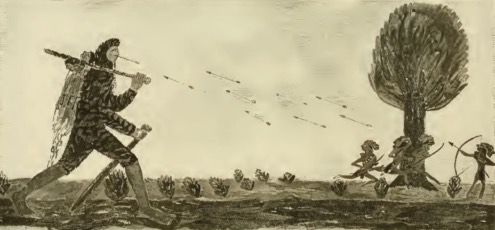
Giants not only in Nevada
And yet the myth of Si-Te-Cah is not the only one that speaks to us of ancient inhabitants of the American continent of gigantic proportions: even the Iroquois, located much further north-east, they tell of Stone coat, "Fur of Stone," a mythological giant (or, in other versions, a race of giants) of stone twice as tall as humans, with a body covered with rock-hard scales, which repel ordinary arrows.
Associated with winter and ice, these giants hunt and eat humans. According to some legends, the Stonecoats they were once humans, who were transformed by a curse into cannibal giants because of their wickedness, a bit like what happens in the Windigo myth of the Chippewa tribe [3]. In other stories, however, the Stonecoats they were a tribe of primeval monsters.
Moving further south, in the Great Plains, Comanche Chief Ray Vibrante told, in 1857, of an ancient race of white giants
“[…] Three meters high which, many moons ago, was more powerful and flourishing than any pale face now living, which inhabited much of the nation, extending from where the sun rises to where it sets. "
By broadening the scope of the research, it can be found that the archetype of the giant is present in many cultures and extends well beyond North America: think, for example, of the Titans and Cyclops of classical memory, the Nephilim of biblical narratives. , to the ogres of Norse mythologies and to the giants of Andean folklore [4]. The Italian anthropologist Mario Polia, in analyzing the recurrence of common traits in various cultures, identifies
"[...] a common tradition persisting through the centuries, whose fundamental elements are the lack of moral laws - the giants were greedy, cannibals and incestuous -, their divinatory capacity - they were seers, they knew the thoughts of God and prevented their punishments -, the ability to work stone, in hydraulic engineering works and in the art of weaving and their negative magical power: they were sorcerers. "
The press and Abraham Lincoln
Leaving behind the mythology and returning to the "unusual" finds in the United States, it must be said that Lovelock Cave does not constitute a unicum. During the nineteenth century, and also in the early twentieth century, there were many finds of bones "of enormous proportions" that rose to the headlines, being sometimes also cited by authoritative sources such as the New York Times. From Ohio to Wisconsin, from Nevada to New Mexico, from Pennsylvania to Washington State, there are dozens and dozens of newspaper articles with bombastic headlines such as: "Amazing Giants", "Giant Skulls Discovered", "Hidden Cave Reveals a Surprising Discovery" . Generally speaking, it is sensationalist articles, which have no following, and, in some cases, of real buffaloes artfully mounted with rudimentary photomontages.
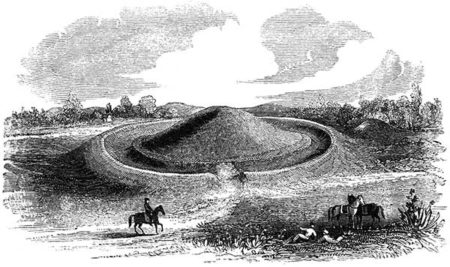
However, such redundancy gives some reason to think. Among the supporters of the existence of giants, there is at least one exceptional testimonial: Abraham Lincoln (1809-1865). In 1848 in Albany, the future President of the United States of America, deeply moved by an extraordinary natural spectacle, gave a speech in which he stated:
" Niagara falls! What is the mysterious force that draws millions and millions of people from all over the world to admire Niagara Falls? [...] When Columbus first discovered this continent - when Christ suffered on the cross - when Moses led Israel across the Red Sea - no, even when Adam first came out of his Creator's hand - then as now, Niagara was here roaring . The eyes of that extinct race of giants whose bones fill the mounds of America have gazed upon Niagara, just like ours at this time. Contemporary with the entire race of men, and older than the first man, the Niagara is as strong and fresh today as it was ten thousand years ago. The Mammoth and the Mastodon - now extinct for so long that only fragments of their monstrous bones remain to testify that one day they lived, they contemplated Niagara […]. "
True, Abraham Lincoln did not go down in history for his contribution to archeology or anthropology, but his words testify, at least, a belief rooted in thinking about time. Not only that, it also emerges from the speech a connection between the giants and the ancient mounds that dot the American territory. The reference is to the Mounds, pre-Columbian constructions dating back to 3500 BC. C. and are mainly present in the Mississippi Valley. These are earthworks, probably with sepulchral and ceremonial purposes, which could have various shapes: truncated pyramids, platforms, truncated or rounded cones or, as in the case of the famous Serpent Mound in Ohio, complex and zoomorphic shapes. Within these earth mounds, there are generally human bones and furnishings, such as weapons or jewels, which indicate their funerary and, presumably, cultic function.
Thomas Jefferson and the enigma of the Mounds
The debate on these mysterious and monumental structures is ancient. One of the first to have a scientific approach to the study of Mounds was another President of the United States, Thomas Jefferson (1743-1826), who, around 1770, excavated a conical mound located near his residence in Monticello, Virginia, known by the name of Indian Grave, in order to investigate how the dead were buried. In the course of the excavations, he came to ascertain that il world: barrow, as it was then called, consisted of a series of mass graves superimposed on each other to form a heap, and found similarities with the funerary customs of the Monacan Indians. Jefferson found a large number of "skulls, jaws, teeth, arm bones, femurs, hands and feet," which he describes with the precision and detachment typical of the scientist, but by no means speaks of giants.
The most recent studies go in the direction traced by Jefferson, that is, they see in Mounds the expression of an indigenous pre-Columbian civilization, but far more imaginative hypotheses have not been lacking, the range of which ranges from the Atlantean populations to the ten lost tribes of Israel, from the Vikings to the ancient Egyptians. In this forest of improbable interpretations, those of William Pidgeon (1800-1880), who, on the basis of rather improvised analyzes and not always adhering to reality, came to hypothesize that the mounds were the product of Dee-Coh-Dah, an older civilization and hostile to Native Americans.
The same Pidgeon, in a book that met a good fortune, before being defeated by the most well-founded analyzes of the archaeologist Theodore H. Lewis, claimed to have managed to interview one of the last descendants of this legendary lineage. Within the Mounds, the bones of the giants would generally occupy a privileged position with respect to the "normal" remains, attesting to a form of respect and pre-eminence: the giants would therefore have been kings and rulers of the builders of these ancient tombs.
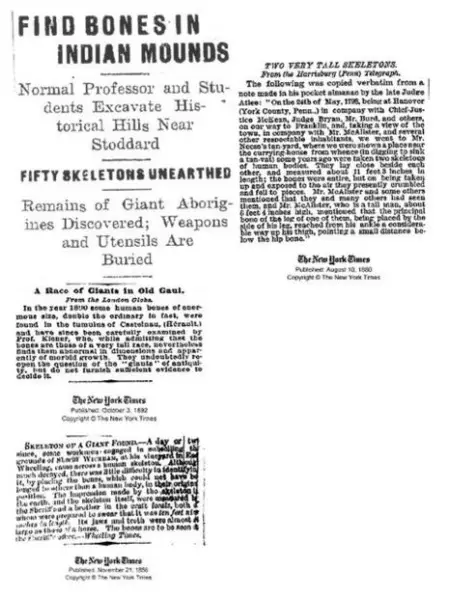
Conclusion
In short, on the one hand we have dozens of articles that tell of human remains of gigantic proportions, on the other we have the scientific community that remains inexplicably indifferent to revelations that could potentially revolutionize our way of looking at the history of the American continent. There are those who say, how Richard Dewhurst, that it is not a simple case and that there is a real design behind the disappearance of the giant skeletons, a programmatic cover-up hatched by the Smithsonian Institution, the well-known research and education institution administered and funded by the United States government, and, in particular, by explorer John Wesley Powell, who ran it from 1879 to 1902.
According to Dewhurst, the reasons for such a hedging operation, at the time, were manifold [5]:
“[…] After the Civil War, the Smithsonian began to adopt the policy of excluding any pre-Columbus foreign influence in the Americas. Some thought it was an attempt by the shattered post-Civil War government to downplay any regional and ethnic conflict in the still fragile post-war national reconstruction. Others have pointed to the expansionist policies embedded in the Manifest Destiny doctrine and the desire to obscure the origins of the tribes deported and annihilated by the expansion to the West. Still others have argued that it was a policy aimed at countering the growing religious problem of Mormons, and their claim that the lost tribes of Israel were to be found in America. "
To these, it should also be added the will to defend evolutionary theory, recently affirmed, by incongruent elements that could have put it in crisis.
However, although Dewhurst's theory may be well documented and not without its charm, it must be admitted that "mainstream" science has other tricks up its sleeve to rule out the existence of giant human beings. Among these, there is the law of the square cube, a mathematical principle enunciated by Galileo Galilei back in 1638, which states that «as the size of a shape increases, its volume grows more than the surface». This principle, applied to biology, implies that, by increasing the size of the human body, the weight and body volume would grow exponentially, causing, for example, the collapse of the bones of the knees and pelvis, or making it impossible for the pump heart and muscles of the whole body. If giants existed, they would have to have a different physical conformation from ours in order to support a much greater weight.
The existence of the ancient rulers of America, therefore, is strongly questioned by two elements: on the one hand, beyond the journalistic stories to which we have referred, there is the impossibility of finding reliable documentary evidence, on the other hand we must note the biological and structural impossibility, a priori, of the existence of human beings with gigantic proportions [6].
It must be admitted, however, that in this ride among Indian legends, ancient ruins and mysterious skeletons, stimulating aspects have emerged not only for the imagination, but also for the deepening of the ancient civilizations of North America. The fascination of these topics did not escape the native anthropologist and activist Vine Deloria Jr. (1933-2005), author of the famous essay Custer died for your sins: an Indian Manifesto, who states that the ancient ruins and connections with the Smithsonian [7]:
"[...] they give us a good reason to believe in the Indiana Jones movie finale - a large deposit in which the true secrets of the history of the earth are buried […] Today's archeology and anthropology have almost sealed the door on our imaginations, generically interpreting the North American past as devoid of any unusual element […]. The great intruder of the ancient burial sites, the nineteenth-century Smithsonian Institution, created a one-way portal, through which countless bones have evaporated. This door and the contents of its vault are virtually inaccessible to anyone other than a government official. Among these bones could lie answers inherent in the deep past, which are not even considered by these officials. "
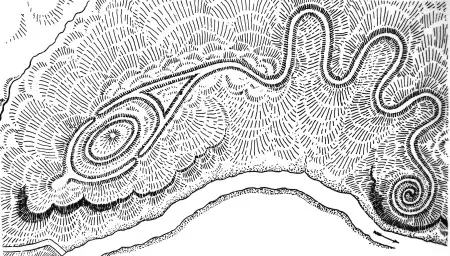
Note:
[1] Sarah Winnemucca Hopkins, Life among the Piutes: their wrongs and claims. It is, among other things, the first autobiographical and ethno-anthropological text written by a native woman.
[2] At most, Meyer argues, it could be a confusion with fossil remains of mammoths or cave bears in the region, whose pelvis bones might remind an untrained observer. If the hypothesis seems absurd, just think of the legend of the Cyclops, which probably originated from an incorrect interpretation of elephant skeletons, whose trunk hole was formerly mistaken for the seat of a single, gigantic eye.
[3] On the Wendigo, cf. Maculotti, Psychosis in the shamanic vision of the Algonquians: The Windigo and Mollar, Jack Fiddler, Wendigo's last hunter.
[4] On giants in Andean myth and folklore, cf. Maculotti, Antediluvian, giant, "gentle" humanity.
[5] Richard Dewhurst, The Ancient Giants Who Ruled America: The Missing Skeletons and the Great Smithsonian Cover-Up.
[6] Unless, of course, they are taken as real unorthodox theories and poorly considered by the academic environment of the last century, such as that of Hans Hörbiger; cf. Pawuels and Bergier, Hans Hörbiger: The Cosmic Ice Theory.
[7] Deloria Jr., Vine, Red Earth, White Lies: Native Americans and the Myth of Scientific Fact.
Bibliography:
- Richard Dewhurst, The Ancient Giants Who Ruled America: The Missing Skeletons and the Great Smithsonian Cover-Up. Bear & Company, 2013.
- Marco Maculotti, Antediluvian, giant, "gentle" humanity.
- Sarah Winnemucca Hopkins, Life among the Piutes: their wrongs and claims. Enhanced Media Publishing, 2017.
- Deloria Jr., Vine, Red Earth, White Lies: Native Americans and the Myth of Scientific Fact. Fulcrum Publications, 1997.

4 comments on “The Si-Te-Cah, ancient giants of Nevada, and the mystery of the "Mounds""